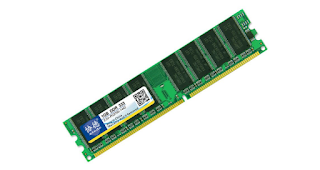For a computer, RAM (random access memory) is a very important component. because the function of this RAM is as a storage of data needed by the processor to run user commands when running an application. the type of RAM is also very diverse, ranging from DDR1, DDR2, to the most recent is DDR3.
for some people, especially those who are unfamiliar with computers, they will have difficulty distinguishing between DDR1, DDR2, or DDR3. especially when it comes to upgrading your computer. because the type of ram will depend on the slot provided by the motherboard. for example, if we buy DDR2 RAM but it turns out that the motherboard only supports DDR1, the newly purchased RAM will be useless because it cannot be installed.
now to avoid this, we must understand the difference between DDR1, DDR2, and DDR3. this time, I will discuss the differences between each type of RAM.
DDR1
DDR1 or DDR stands for (Double Data Rate) the first generation that uses double clock cycle technology so that it can transfer data faster than single data rate type.
DDR1 has several types, namely :
DDR-200 = > has a memory clock of 100MHz)
DDR-266 has a memory clock of 133 MHz
DDR-333 has a memory clock of 166 MHz
DDR-400 has a memory clock of 200 Mhz.
unfortunately, the development of DDR1 was only until 2000 due to the development of the Times. the difference seen from the physical is the type of DDR memory chip (IC) used is the type of TSOP (Thin Small-Outline Package). the shape is rectangular with legs on the left and right. although there are some that use BGA type ICS, they are very rare to find.
the total number of pins in DDR1 is 184 (92 pins on each side).
DDR2
This DDR2 RAM has twice as many clock cycles and the ability to read faster than DDR1. The Memory clock is available from 100Mhz to 266 MHz and the transfer frequency is between 400-1966 MHz. types of DDR2 include :
DDR2-400
DDR2-533
DDR2-667
DDR2-800
DDR2-1066
the type of memory chip used by DDR2 is BGA (Ball Grid Away). the shape is rectangular and there is also a square. another difference is that the notch available on the memory slot connector board is located a little more in the middle of the memory module board compared to DDR. DDR2 has smaller pins that number as many as 240 pieces ( 120-pin on each side ).
DDR3
The bigger the ddrnya the better the shape, maybe that's what you have in mind when you see a glimpse of a photo of these three types of RAM. if we look in terms of memory clocknya not much different from DDR2 is ranging from 100 MHz to 266 MHz. however, the difference lies in the higher transfer rate frequency that reaches 2133 MHz and a more efficient electrical voltage of only 1.5 V while DDR2 requires a voltage of 1.8 V and DDR1 2.5 V. this is because DDR3 has embedded 90nm technology so it can save power by 16%. the number of pins is the same as DDR2 which is 240 pieces, only the notch is located more to the left (see picture).
for the conclusion can be seen from the following picture where the notch location of each type is different.
That's the short article I wrote, Hopefully after reading this article, you can find out the difference in ram types between DDR1, DDR2, and DDR3.
DDR 4
The DDR4 RAM generation began to be crowded in the market around 2013-2015. DDR4 already supports transfer rates between 2133-4266MT / s and Clock speeds of 1066 - up to 2133MHz. It is the best RAM generation in 2018-2019, but because it is the best type, it means that the price is comparable.
DDR4 RAM is also widely known to users as DDR4 SDRAM which has a high memory clock and memory bus but with low power consumption of only 1.05 v only.
Please note that currently not all CPU devices can accept DDR4, only a few high processor series can use this generation of RAM.
- DDR4 has a memory density of up to 16 GB.
- DDR4 has lower voltage, which is 1.2 V thus DDR 4 will be more power efficient.
DDR4 RAM has 288 pins.
- DDR4 has a module with a smaller size, where this small size is used in mobile devices, one of which is a laptop.
- SO-DIMM DDR4 has a pin count of 260 pins.





Post a Comment for "Make the difference feature RAM DDR1, DDR2, DDR3, DDR4"